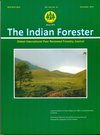The Science behind Taboos: A Case Study of Butea monosperma in the Indian Thar Desert
DOI:
https://doi.org/10.36808/if/2016/v142i12/108420Abstract
No Abstract.References
Banjo A.D., Otufale G.A., Abatan O.L. and Banjo E.A. (2006). Taboo as a means of plant and animal conservation in South-Western Nigeria: a case study of Ogbe River and its basin. World Appl. Sci. J., 1: 39–43.
Bhargava S.K. (1986). Estrogenic and postcoital anticonceptive activity in rats of butin isolated from Butea monosperma seed. J. Ethnopharmacology, 18: 95-101.
Colding J. and Folke C. (1997). The relations among threatened species, their protection, and taboos. Conservation Ecology, 1:1–6.
Dixit V.P., Bhargava S.K. and Gupta R.A. (1981). Hyperglycemia induced testicular dysfunction after chronic administration of Balanites roxburghii Planch fruit pulp extract in dog (Cannis indicus). Indian J. Exp. Biol., 19: 918-921.
Kirtikar K.R. and Basu B.D. (1935). Indian Medicinal Plants. Lalit Mohan Basu Publishers, Allahabad, India, p. 785.
Nadkarni A.K. (1954). Indian Materia Medica, Vol. 1, Popular Book Depot, Bombay: 222 – 224.
Sharma N. and Garg V. (2009). Antidiabetic and antioxidant potential of ethanolic extract of Butea monosperma leaves in alloxan-induced diabetic mice. Indian J. Biochem Biophys., 46 (1): 99-105.
Shah K.G. Baxi A.J. Shukla V.J., Dave K.K. and De S. (1990). Phytochemical studies and antiestrogenic activity of Butea frondoa flowers. Indian J. Pharmaceutioal Sciences, 52 (6): 272-275.
Tarannum S., Mohamed R. and Vishwanath B.S. (2012). Inhibition of testicular and Vipera russelli snake venom hyaluronidase activity by Butea monosperma (Lam) Kuntze stem bark. Nat. Prod. Res., 26(18): 1708-11.
Downloads
Downloads
Published
How to Cite
Issue
Section
License
Unless otherwise stated, copyright or similar rights in all materials presented on the site, including graphical images, are owned by Indian Forester.





